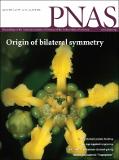| dc.contributor.author | Zhang, Wenheng | |
| dc.contributor.author | Kramer, Elena M. | |
| dc.contributor.author | Davis, Charles Cavender | |
| dc.date.accessioned | 2011-10-18T14:02:51Z | |
| dc.date.issued | 2010 | |
| dc.identifier.citation | Zhang, Wenheng, Elena M. Kramer, Charles C. Davis. 2010. Floral symmetry genes and the origin and maintenance of zygomorphy in a plant-pollinator mutualism. Proceedings of the National Academy of Sciences 107(14):6388-6393. | en_US |
| dc.identifier.issn | 0027-8424 | en_US |
| dc.identifier.issn | 1091-6490 | en_US |
| dc.identifier.uri | http://nrs.harvard.edu/urn-3:HUL.InstRepos:5241353 | |
| dc.description.abstract | The evolution of floral zygomorphy is an important innovation in flowering plants and is thought to arise principally from specialization on various insect pollinators. Floral morphology of neotropical Malpighiaceae is distinctive and highly conserved, especially with regard to symmetry, and is thought to be caused by selection by its oil-bee pollinators. We sought to characterize the genetic basis of floral zygomorphy in Malpighiaceae by investigating CYCLOIDEA2-like (CYC2-like) genes, which are required for establishing symmetry in diverse core eudicots. We identified two copies of CYC2-like genes in Malpighiaceae, which resulted from a gene duplication in the common ancestor of the family. A likely role for these loci in the development of floral zygomorphy in Malpighiaceae is demonstrated by the conserved pattern of dorsal gene expression in two distantly related neotropical species, Byrsonima crassifolia and Janusia guaranitica. Further evidence for this function is observed in a Malpighiaceae species that has moved to the paleotropics and experienced coincident shifts in pollinators, floral symmetry, and CYC2-like gene expression. The dorsal expression pat-tern observed in Malpighiaceae contrasts dramatically with their actinomorphic-flowered relatives, Centroplacaceae (Bhesa paniculata) and Elatinaceae (Bergia texana). In particular, B. texana exhibits a previously undescribed pattern of uniform CYC2 expression, suggesting that CYC2 expression among the actinomorphic ancestors of zygomorphic lineages may be much more complex than previously thought. We consider three evolutionary models that may have given rise to this patterning, including the hypothesis that floral zygomorphy in Malpighiaceae arose earlier than standard morphology-based character reconstructions suggest. | en_US |
| dc.description.sponsorship | Organismic and Evolutionary Biology | en_US |
| dc.language.iso | en_US | en_US |
| dc.publisher | National Academy of Sciences | en_US |
| dc.relation.isversionof | doi:10.1073/pnas.0910155107 | en_US |
| dc.relation.hasversion | http://www.people.fas.harvard.edu/~ccdavis/pdfs/Zhang_et_al_PNAS_2010.pdf | en_US |
| dash.license | LAA | |
| dc.subject | CYCLOIDEA | en_US |
| dc.subject | development | en_US |
| dc.subject | gene duplication | en_US |
| dc.subject | Malpighiaceae | en_US |
| dc.subject | phylogeny | en_US |
| dc.title | Floral Symmetry Genes and the Origin and Maintenance of Zygomorphy in a Plant-pollinator Mutualism | en_US |
| dc.type | Journal Article | en_US |
| dc.description.version | Version of Record | en_US |
| dc.relation.journal | Proceedings of the National Academy of Sciences | en_US |
| dash.depositing.author | Davis, Charles Cavender | |
| dash.waiver | 2010-02-24 | |
| dc.date.available | 2014-10-22T07:30:44Z | |
| dc.identifier.doi | 10.1073/pnas.0910155107 | * |
| dash.contributor.affiliated | Zhang, Wenheng | |
| dash.contributor.affiliated | Kramer, Elena | |
| dash.contributor.affiliated | Davis, Charles | |


